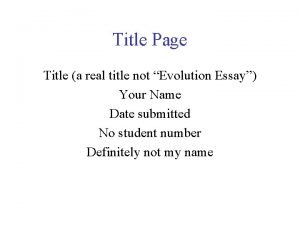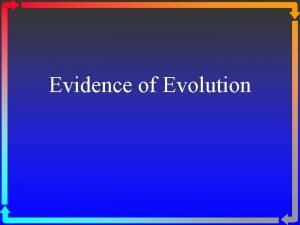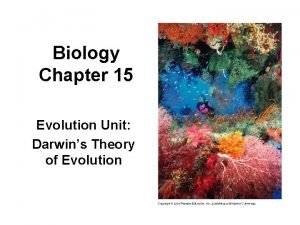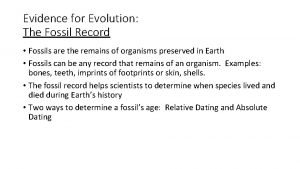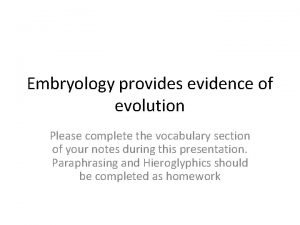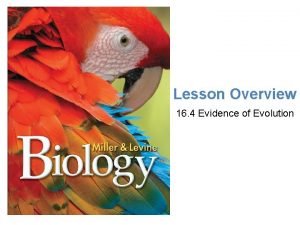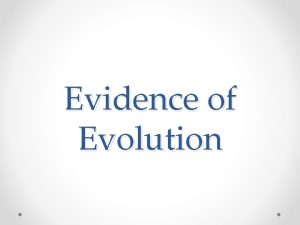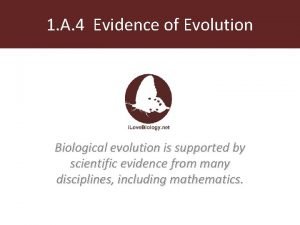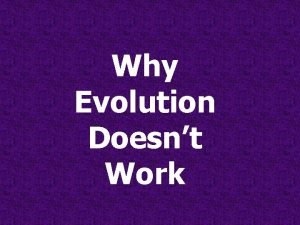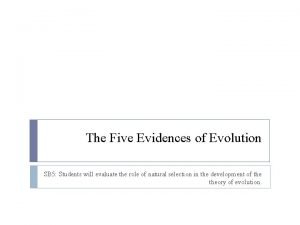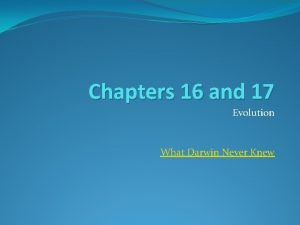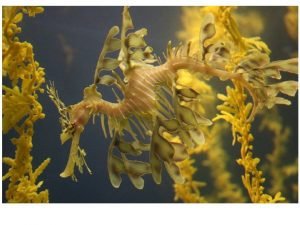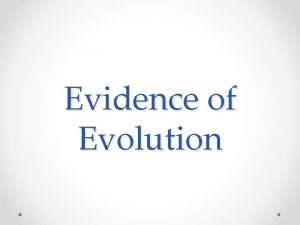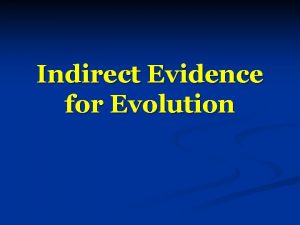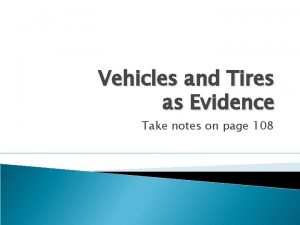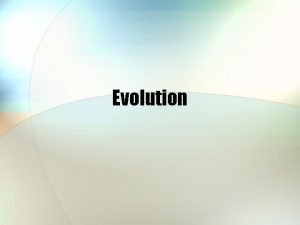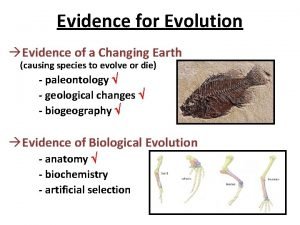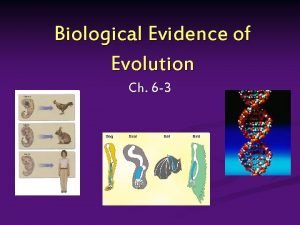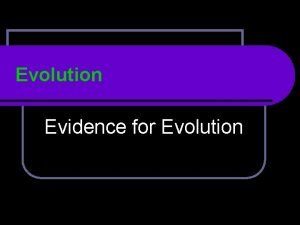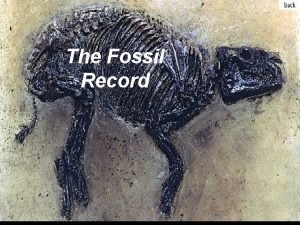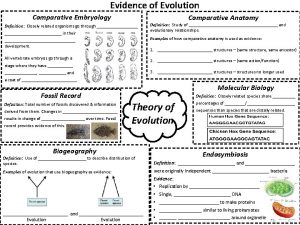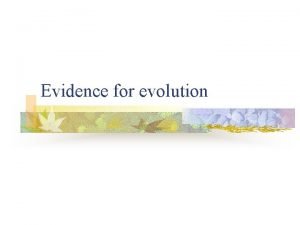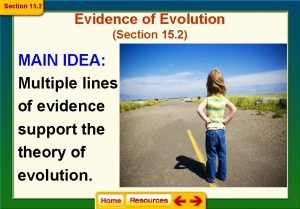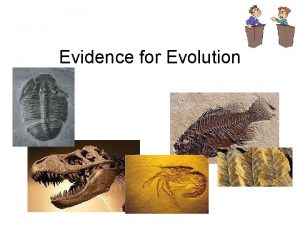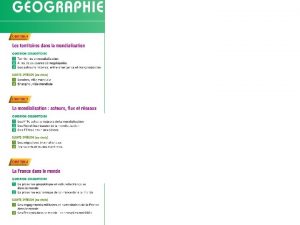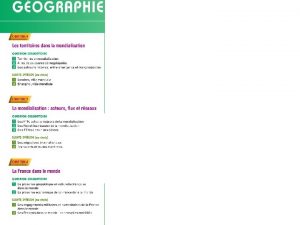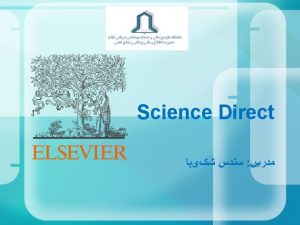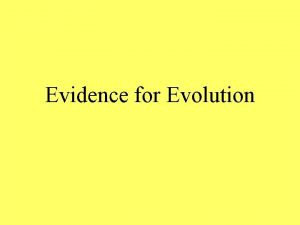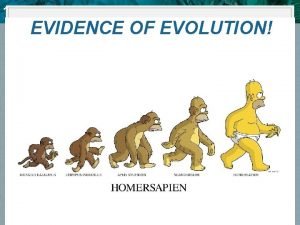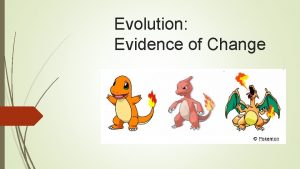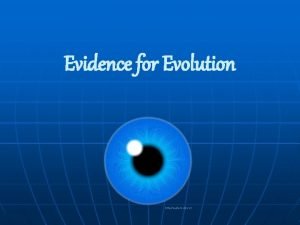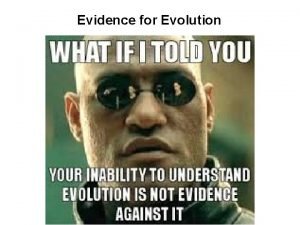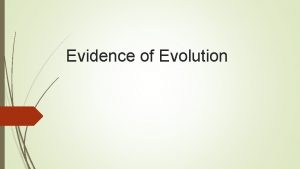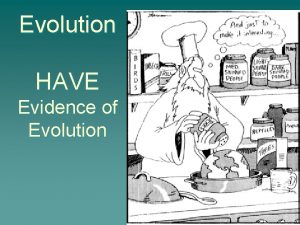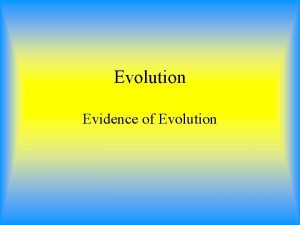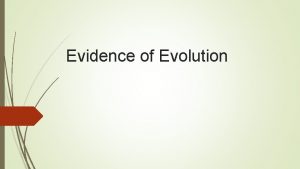Evidence for Evolution Page 1 Evidence for Evolution




































- Slides: 36

Evidence for Evolution Page 1

Evidence for Evolution • ‘Theory of evolution by natural selection’ called the greatest idea anybody has ever had • “Today scientists have as much confidence in evolution as they do in the existence of atoms or that microorganisms cause infectious disease. ” Jerry A. Coyne Page 2

Fossil Record • • Show which species were alive in the past provides evidence that living things have evolved fossils show different groups of organisms have changed over time Still very incomplete Archaeopteryx Page 3

Fossil Record • • • Fossils in young layers of rock are more similar to today’s species than do older fossils Fossils appear in chronological order in rock layers Not all organisms appear in the fossil record at the same time Page 4

Transitional Forms • • • Incorrectly called ‘missing links’ None when Darwin wrote ‘Origin of Species’ Show links between groups of organsims Hundreds found to date Eg. Dorudon was an ancient terrestrial whale (pelvis; short legs) Page 5

Transitional Forms • Eg. Atrociraptor was a link between dinosaurs and birds (Archaeopteryx) • Eg. Tiktaalik roseae show amphibians may have rose from fish • Eyes on top like a salamander, ribs, could breathe air Page 6

Name these critters coelurosaurus archaeopteryx chicken Page 7

Fossil Record Page 8

Biogeography • • Past and present distribution of species Darwin & Wallace speculated that species evolve in one location and then spread out Plants in S. Am. And Africa same Marsupial fossils found in Antarctica Southern super-continent Gondwana Page 9

Biogeography • • Geographically close environments are more likely to contain related species than locations that are distant locations that are environmentally similar (eg. Desert in Africa and a desert in Australia) Animals found on islands often resemble animals from the closest continent (evolution from mainland migrants) Fossils of same species found on the coastline of neighbouring continents (eg. Gondwana) Related species almost never found in exactly same location or habitat Page 10

Biogeography • Marsupials (Australia) birth undeveloped baby; matures in pouch • Placentals (N. & S. America) give birth to fully developed babies • Remarkably similar forms • “Convergent evolution” Page 11

Primate fossils • • Recent finds have closed the gaps on the link between apes and humans Eg. Raccoon-sized primate with opposable thumbs and nails instead of claws found in Germany (2009) Page 12

Primate fossils • Darwin proposed that all hominids (human -like) originated from primates in Africa • That’s where most fossils are found! • DNA can confirm relationships found in fossils • We have enough to see our evolution but the record is very incomplete! Page 13

Primate Brain Development • Human brain size has tripled compared to our earliest hominid ancestors Page 14

Ranges of Cranial capacities among living apes (from Falk, 1986) Page 15

Australopithecus Homo erectus Homo sapiens Page 16

Page 17

Primate Bone structure • • • Bone sizes and shapes gradually become similar to modern humans’ over time Pelvis, femur, digits, etc. Changes overlay changes in environment (from trees to land) Page 18

Ardipithecus • • “Ardi” Oldest human ancestor (4. 4 myo) Unearthed in Ethiopia (2008) Bipedal due to hip and toe modifications Page 19

Ardipithecus • Ardi video Page 20

Page 21

Australopithecus afarensis Homo habilis = handy human (1. 5 to 2 mya) Homo erectus (1. 6 mya) Page 22

Neanderthals 35, 000 to 100, 000 ya Cro-Magnon 35, 000 to 40, 000 ya Page 23

Homo sapiens < 100, 000 ya Page 24

Embryonic Development • • Many species look similar in early stages of development Provides evidence of a common ancestry Page 25

Embryonic Development Page 26

Homologous Structures • • Different mature forms that arose from same embryonic tissue Eg. Wing of a bat, flipper of a whale, human arm, etc. Turtle Alligator Bird Page 27

Homologous Body Structures Page 28

Vestigial Organs • • • Remnants of homologous organs in other species Eg. Pelvis and leg bones in whales when they use to live on land What we’d expect if nature weeded out useless traits Page 29

Vestigial Organs • Keys to our primate ancestry – – Tailbone (remnants of tail) Appendix (fermenting vessel to digest cellulose) Arrector pili muscles (“goosebumps”) 3 scalp muscles (ear wiggling) Page 30

Atavisms • From Latin: ‘ancestor’ • Reappearance of old traits • Eg. One in 500 whales is born with protruding legs • Eg. Human babies born with vestigial tails • Eg. Horses born with more than one toe (splint toes) • Mutations ‘turn on’ dead genes Page 31

• Is evolution happening right now? Page 32

“In vitro” evolution • Microbes can adapt to virtually any laboratory condition (heat, antibiotics, toxins, starvation, predators, etc. ) • E. Coli tested in lab over 18 year study: – Created feast or famine environment – Latest offspring grow 70% faster than original – Scientists identified at least 9 DNA mutations resulting in adaptations Page 33

Antibiotic resistance • Drugs evolve to thrive in human envt. – Eg. In 1941 penicillin wipes out all Staphylococcus bacteria; by 2009 95% of Staph. strains are resistant to penicillin – Eg. AIDS treatment requires 3 -drug cocktail because virus mutates at a rapid pace – Insects resistant to DDT – Plants adapted to herbicides – Many others! Page 34

Are humans evolving? • Lactose tolerance – not needed after weaning in many regions (no lactase enzyme) – Pastoral areas (raise cows) keep lactase turned on (3000 to 8000 years ago) – Simple DNA mutation • Amylase gene – Highly duplicated in humans, not so much in lower apes (due to our starchy diets) Page 35

Are humans evolving? • Conversely, improvements in nutrition, sanitation, and medical care curbing natural selection • Bad eyesight cured with glasses; bad teeth fixed by dentists • How many of our ancestors with bad eyes and teeth, unable to hunt, would have survived on the African savanna? • De-evolution…possibly? Page 36
 Does apa format need a title page
Does apa format need a title page Evolution title page
Evolution title page 4 types of evidence for evolution
4 types of evidence for evolution Evidence of evolution
Evidence of evolution The fruit of evolution chapter 15
The fruit of evolution chapter 15 How amber is formed
How amber is formed Example of evolution
Example of evolution Animal embryos
Animal embryos What are the 4 types of evidence for evolution
What are the 4 types of evidence for evolution Fish tail bird
Fish tail bird Evidence of evolution
Evidence of evolution 5 evidence of evolution
5 evidence of evolution Evidence of evolution stations answer key
Evidence of evolution stations answer key Molecular biology evidence of evolution
Molecular biology evidence of evolution Bottleneck effect
Bottleneck effect What are the four types of evidence for evolution
What are the four types of evidence for evolution Indirect evidence of evolution
Indirect evidence of evolution Evidence for evolution doodle notes
Evidence for evolution doodle notes Embryological evidence of evolution
Embryological evidence of evolution Lamarck's theory
Lamarck's theory Biological evidence of evolution
Biological evidence of evolution Evidence of evolution
Evidence of evolution Evidence of evolution of remnants and impressions *
Evidence of evolution of remnants and impressions * Comparative embryology definition
Comparative embryology definition Embryology evidence of evolution
Embryology evidence of evolution Evidence of evolution section 15-2 review
Evidence of evolution section 15-2 review Class evidence can have probative value
Class evidence can have probative value Jobs vancouver
Jobs vancouver Primary evidence vs secondary evidence
Primary evidence vs secondary evidence A pair of latex gloves was found at a crime scene
A pair of latex gloves was found at a crime scene Fiber evidence can have probative value.
Fiber evidence can have probative value. Primary evidence vs secondary evidence
Primary evidence vs secondary evidence Amphiboly fallacy
Amphiboly fallacy Class evidence vs individual evidence
Class evidence vs individual evidence Primary evidence vs secondary evidence
Primary evidence vs secondary evidence What is primary sources
What is primary sources Bästa kameran för astrofoto
Bästa kameran för astrofoto

